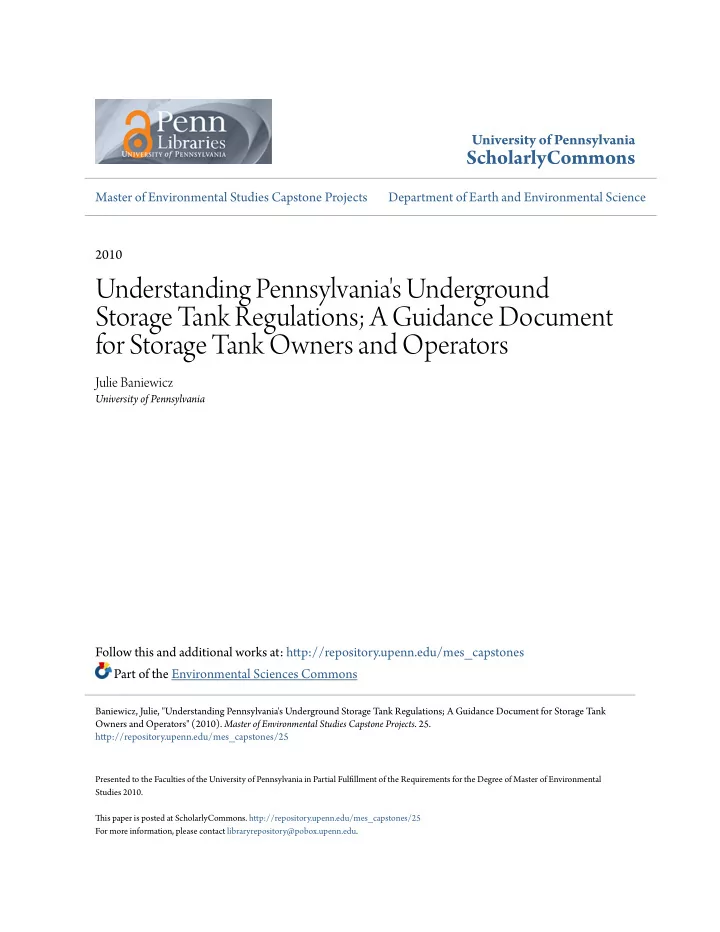

University of Pennsylvania ScholarlyCommons Master of Environmental Studies Capstone Projects Department of Earth and Environmental Science 2010 Understanding Pennsylvania's Underground Storage Tank Regulations; A Guidance Document for Storage Tank Owners and Operators Julie Baniewicz University of Pennsylvania Follow this and additional works at: htup://repository.upenn.edu/mes_capstones Part of the Environmental Sciences Commons Baniewicz, Julie, "Understanding Pennsylvania's Underground Storage Tank Regulations; A Guidance Document for Storage Tank Owners and Operators" (2010). Master of Environmental Studies Capstone Projects . 25. htup://repository.upenn.edu/mes_capstones/25 Presented to the Faculties of the University of Pennsylvania in Partial Fulfjllment of the Requirements for the Degree of Master of Environmental Studies 2010. Tiis paper is posted at ScholarlyCommons. htup://repository.upenn.edu/mes_capstones/25 For more information, please contact libraryrepository@pobox.upenn.edu.
Understanding Pennsylvania's Underground Storage Tank Regulations; A Guidance Document for Storage Tank Owners and Operators Abstract Tiis capstone project is a proactive approach to addressing a problem observed in many underground storage tank facilities; owners and operator failure to understand the Pennsylvania state regulations. Tie Pennsylvania Department of Environmental Protection (PA DEP) enacted the Storage Tank and Spill Prevention Act in 1989. Now, twenty years later, government regulators are still struggling to achieve a high rate of compliance at storage tank facilities. Most of the non-compliant storage tank facilities in question are gas stations. Some of the factors contributing to the non-compliance are: limited understanding of the English language; complexity of the regulations; constant evolution of the regulations; and the ignorance of responsibility and consequences. In many cases, these impediments lead to an apathetic atuitude toward the requirements. I have created a plain-language guidance document that explains storage tank systems and key regulations. My goal is to have the document published by the PA DEP so that it may be handed out to the regulated community. Over the next few years, Pennsylvania will be implementing a federally mandated operator training. Tiis document would be a great complement to the training goals of the federal and state government agencies. In addition, achieving compliance at underground storage tank facilities is of great importance for protecting our groundwater supplies. Pennsylvania has had over 14,000 releases of regulated substances from storage tanks since 1989. Groundwater is an extremely valuable resource for drinking water purposes as well as for the natural environment. My document will assist storage take owners and operators in understanding the regulations, which will lead to a greater level of compliance with the regulations, and fewer release incidents. Disciplines Environmental Sciences | Physical Sciences and Mathematics Comments Presented to the Faculties of the University of Pennsylvania in Partial Fulfjllment of the Requirements for the Degree of Master of Environmental Studies 2010. Tiis thesis or dissertation is available at ScholarlyCommons: htup://repository.upenn.edu/mes_capstones/25
UNDERSTANDING PENNSYLVANIA’S UNDERGROUND STORAGE TANK REGULATIONS; A GUIDANCE DOCUMENT FOR STORAGE TANK OWNERS AND OPERATORS Julie Baniewicz Spring 2010 Stanley Laskowski Kathy Nagle
ii Abstract This capstone project is a proactive approach to addressing a problem observed in many underground storage tank facilities; owners and operator failure to understand the Pennsylvania state regulations. The Pennsylvania Department of Environmental Protection (PA DEP) enacted the Storage Tank and Spill Prevention Act in 1989. Now, twenty years later, government regulators are still struggling to achieve a high rate of compliance at storage tank facilities. Most of the non-compliant storage tank facilities in question are gas stations. Some of the factors contributing to the non-compliance are: limited understanding of the English language; complexity of the regulations; constant evolution of the regulations; and ignorance of responsibilities and consequences. In many cases, these impediments lead to an apathetic attitude towards the requirements. I have created a plain-language guidance document that explains storage tank systems and key regulations. My goal is to have the document published by the PA DEP so that it may be handed out to the regulated community. Over the next few years, Pennsylvania will be implementing a federally mandated operator training. This document would be a great complement to the training goals of the federal and state government agencies. In addition, achieving compliance at underground storage tank facilities is of great importance for protecting our groundwater supplies. Pennsylvania has had over 14,000 releases of regulated substances from storage tanks since 1989. Groundwater is an extremely valuable resource for drinking water purposes as well as for the natural environment. My document will assist storage tank owners and operators in understanding the regulations, which will lead to a greater level of compliance with the regulations, and fewer release incidents.
iii TABLE OF CONTENTS CHAPTER ONE.........................................................................................................................1 Introduction.........................................................................................................................1 Statement of the Problem ....................................................................................................1 Purpose of the Study............................................................................................................1 Need for Research...............................................................................................................1 Hypothesis ..........................................................................................................................2 Research Questions .............................................................................................................2 Definition of Terms.............................................................................................................2 CHAPTER TWO........................................................................................................................3 Literature Review ................................................................................................................3 Storage Tank Regulation History.........................................................................................3 Groundwater .......................................................................................................................4 Impediments of Compliance................................................................................................4 Operator Training................................................................................................................5 Summary.............................................................................................................................6 CHAPTER THREE ....................................................................................................................7 Research Design & Methodology ........................................................................................7 Proposed Evaluation Design................................................................................................7 Methods ..............................................................................................................................7 Quantitative Analysis ..........................................................................................................8 CHAPTER FOUR........................................................................................................................... 9 Results..................................................................................................................................... 8
iv Discussion............................................................................................................................... 8 Conclusion............................................................................................................................... 9 REFERENCES.........................................................................................................................10
Recommend
More recommend